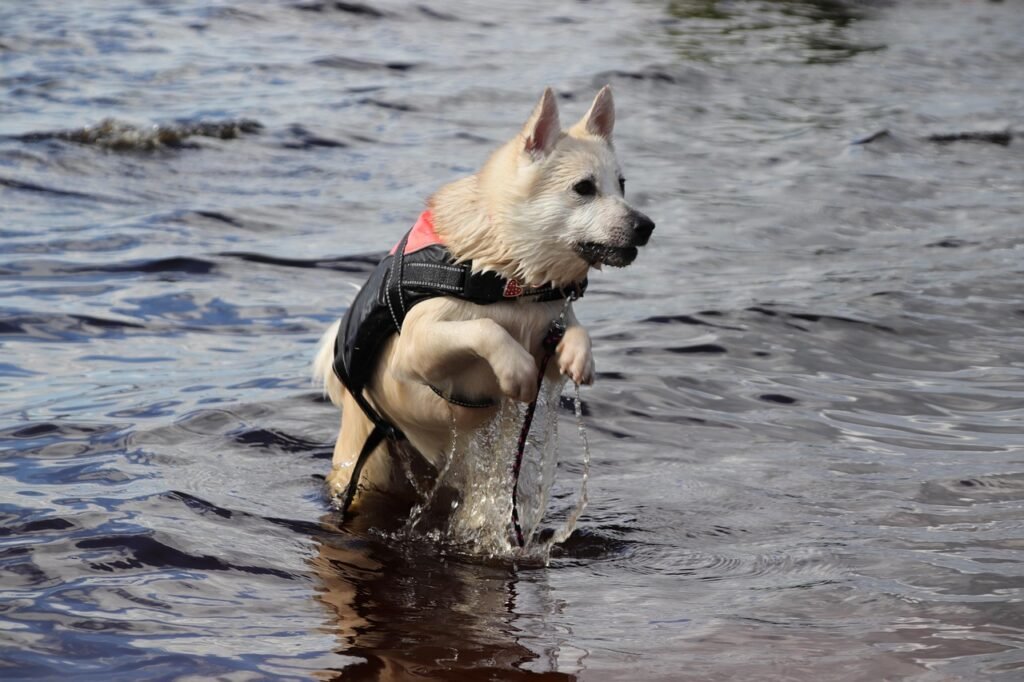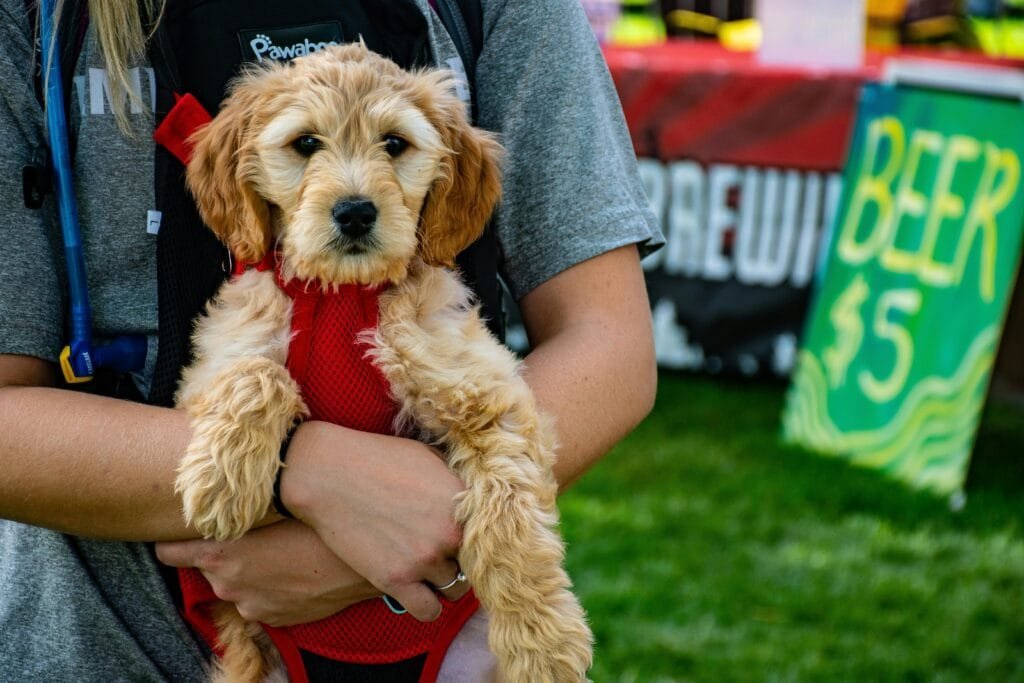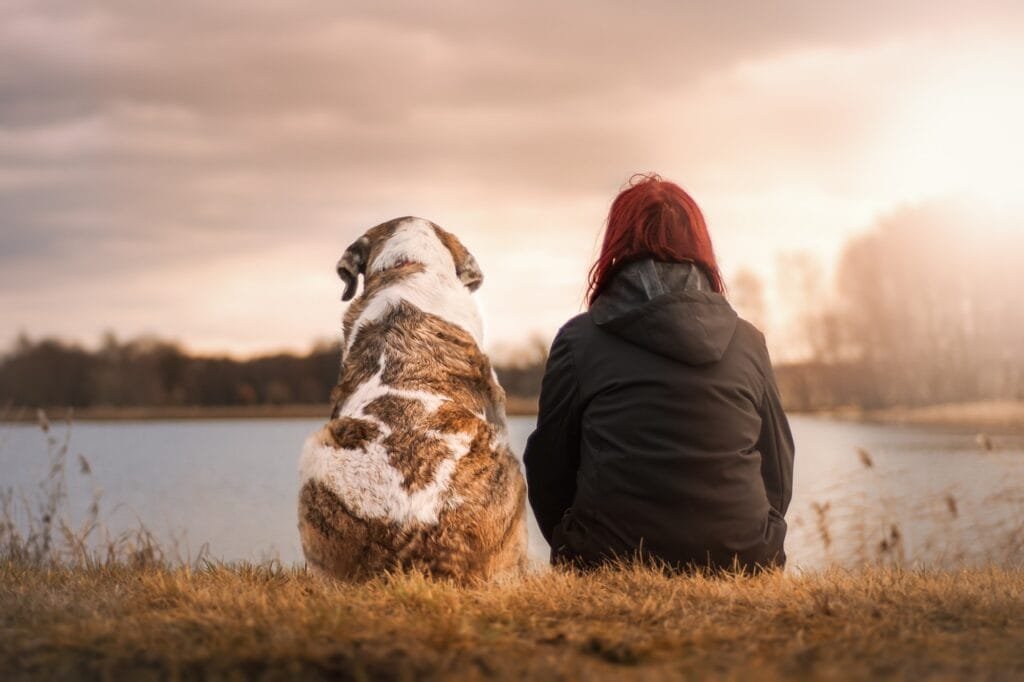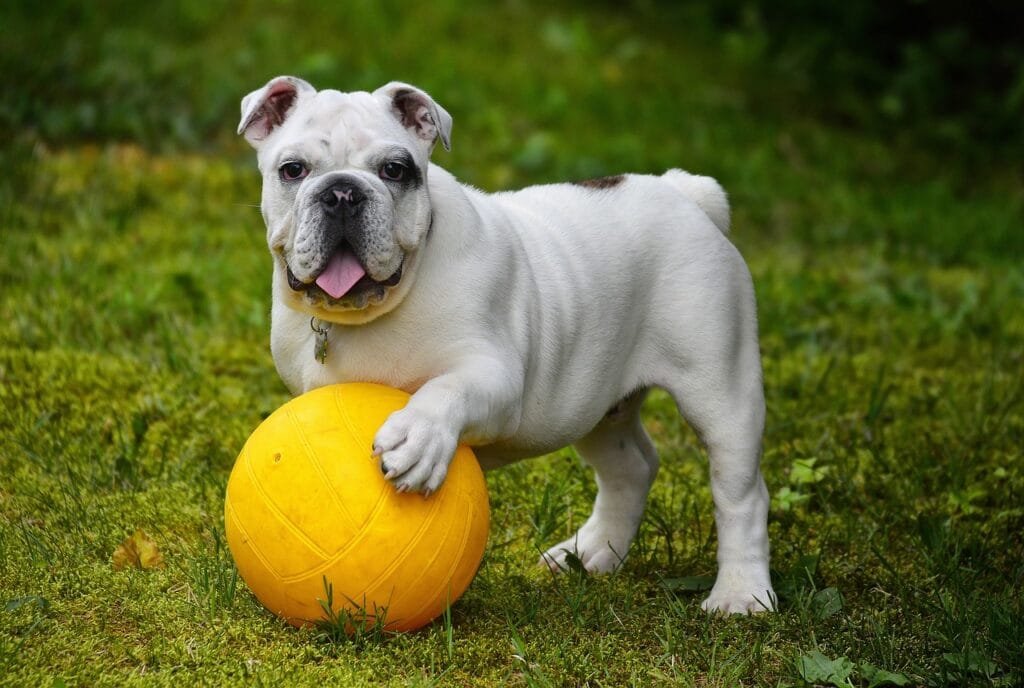Swimming with dogs: Safety, training tips, and Montreal spots
Let’s be honest. Swimming with dogs can be magical… or a total mess.
Some dogs charge into the water like they were born for it. Others hover at the shoreline, uncertain but curious. And then there are those who freeze, panic, or turn and sprint the other way. None of it is wrong. Swimming isn’t one-size-fits-all, and not every dog is going to love it right away. Some never will.
That said, swimming with dogs can be a joyful, confidence-building experience when it’s done thoughtfully. It’s also one of the best ways to help your dog stay active and cool during Montreal’s sticky summers. You don’t need a private lake or a perfectly behaved retriever. You just need a plan, a good read on your dog, and a willingness to go at their pace.
This post will walk you through how to tell if your dog is ready, how to set them up for success, what to bring, where to go near Montreal, and how to keep everyone safe while having fun.
Is your dog actually into this?
Some dogs seem built for the water. Others are still figuring it out. And a lot fall somewhere in between.
Swimming with dogs starts with listening. Not to what you hope they’ll enjoy, but to what they’re telling you with their body. If they’re curious around shallow water, love splashing in puddles, or seem intrigued by sprinklers or kiddie pools, that’s a good sign. If they freeze, tuck their tail, or look away as soon as the water moves, it’s probably not the right time.
A gentle introduction matters. Let your dog investigate from a safe distance. Reward for curiosity. Don’t lure, drag, or toss them into deeper water. That might feel like a shortcut, but it can cause serious trust issues and even panic responses that stick.
Some dogs need weeks to feel comfortable dipping their paws. Others surprise you by paddling out like pros. Both are normal. The goal isn’t to force it. The goal is to make swimming with dogs feel fun and safe for both of you.
How to teach your dog to swim
Teaching swimming isn’t about performance. It’s about helping your dog feel confident in their body, understand how to move in water, and know how to get out safely.
Start in calm, shallow water. A gradual entry is key. Lakes, gently sloping rivers, or a kiddie pool are great for this. Let your dog wade in slowly. Stay close, talk to them, toss treats nearby, and follow their lead.
If your dog is hesitant, walk into the water alongside them. Let them feel how it changes gradually, not all at once. Use praise, treats, and toys to make the whole experience feel like a game.
The team at PetMD recommends supporting your dog’s belly or using a life jacket for buoyancy while they’re learning. This helps them figure out how to paddle with all four paws instead of just flailing with their front legs. AKC trainer Mary Godlevski describes this as “front-wheel drive”; dogs new to swimming often forget they have back legs. A life jacket helps keep their body level, which makes it easier for them to learn full-body movement and build confidence in the water.
Imitation works too
If you know a dog who swims comfortably and your dog gets along with them, that’s a golden opportunity. Watching another dog enjoy the water can make a huge difference. If the vibe is right, they might follow their friend right in, especially if you’re close by, encouraging and calm.
Let them splash. Let them pause. Let them get out and re-enter on their own. Every step is progress.
Must-have gear for swimming with dogs
Before you pack the car, take a minute to make sure you’ve got the essentials. The right setup makes a huge difference. Not just for fun, but for safety too.
- Dog life jacket
Look for one with a sturdy handle, adjustable straps, and bright, reflective fabric. Bonus points if it has a chin float and leash clip. - Fresh water and bowl
Bring a collapsible bowl or portable dog water bottle. Don’t let your dog drink from pools, lakes, or oceans. - Dog-safe sunscreen
Use on light-coated dogs or pink noses. Always choose a product made specifically for dogs, and ask your vet if you’re unsure. - Floating toys
Choose soft, flat, and lightweight toys that float and are easy to spot. Avoid anything too large or heavy. Think soft discs or bumpers rather than large tennis balls. - Dog towel (or fast-drying travel towel)
Dry them off after swims and keep your gear, or car, a little less soaked. - Dog first aid kit
Include basics like bandages, tweezers, saline rinse, and contact info for the nearest emergency vet. - Leash, collar, ID tags
Even if you’re headed to an off-leash area, always bring them along. Rules can change fast, and ID tags are a must near water. - Rubber mat for kiddie pools
A simple way to help dogs stay stable on slippery plastic. Great for nervous swimmers.
Before you go, check local rules around leash laws and water access. Some public beaches or rentals may have restrictions, and others might post water quality alerts.
Helpful extras worth packing
Even if you’re staying close to home, a few smart additions can make your swim day smoother. These help keep your dog cool, safe, and comfortable from start to finish.
- Non-slip water shoes (for you)
Handy for rocky shorelines, muddy banks, or slippery pool ramps. Staying steady makes it easier to support your dog and avoid accidental falls. - Portable shade
A pop-up tent or beach umbrella gives your dog a place to cool off during breaks, especially in open areas with no trees. - Cooling vest or bandana
Helps manage body temperature during downtime or on the walk home. - Breathable dog boots or paw balm
Protects your dog’s paws from hot pavement, rough terrain, or sharp rocks on the way to or from the water. - Waste bags and a sealable container
Always clean up. A screw-top jar or zip bag keeps things tidy if there’s no trash bin nearby. - Small blanket or mat
Gives your dog a clean spot to settle and keeps their belly off hot sand, gravel, or concrete. Also helpful if you’re taking breaks or picnicking nearby.
Safety tips for swimming with dogs
Let’s talk safety. Because swimming with dogs isn’t just a cute summer activity. It comes with real risks, especially if you’re not watching closely.
1. Mind the temperature
Montreal water can stay chilly well into early summer. Aim for a warm day, and check that the water doesn’t feel too cold to your touch. If it’s brisk enough to make you hesitate, it’s likely too cold for your dog. This is especially true for puppies and smaller breeds. Cold water can lead to cramping, swimmer’s tail (a droopy, painful tail), or even hypothermia in sensitive dogs.
2. Keep sessions short
Excited dogs sometimes forget to rest. Watch for signs of fatigue like heavy panting, slowing down, or gulping water. Stick to 10-minute swims, then take a break. You can always go again.
3. Limit water intake
Dogs can accidentally swallow too much water while swimming, which may lead to water toxicity. If your dog throws up after a swim, or seems bloated or sluggish, call your vet. Offering food (like a freeze-dried snack) after swimming can help absorb some of that water.
4. Watch for natural hazards
Even peaceful lakes can hold surprises. Be cautious around visible algae, stagnant water, sharp rocks, or hidden critters like snapping turtles or fishhooks. Dogs will gobble up bait, hook and all, before you can stop them. Always scan the area first.
5. Rinse and dry off
Rinse your dog after every swim, especially if the water had chlorine, salt, or algae. Dry their ears gently to reduce the risk of infection.
6. Help your dog learn how to get out
This one’s easy to overlook, but it really matters. Before you go deep, make sure your dog knows where and how to exit the water. Guide them to the shore, the steps, or the pool ramp a few times so they can find it on their own.
If you’re swimming with them, hang out near the exit and encourage them toward it. If you’re staying dry, position yourself where they can clearly see the way out. Confusion here can cause panic or make your dog avoid swimming altogether.
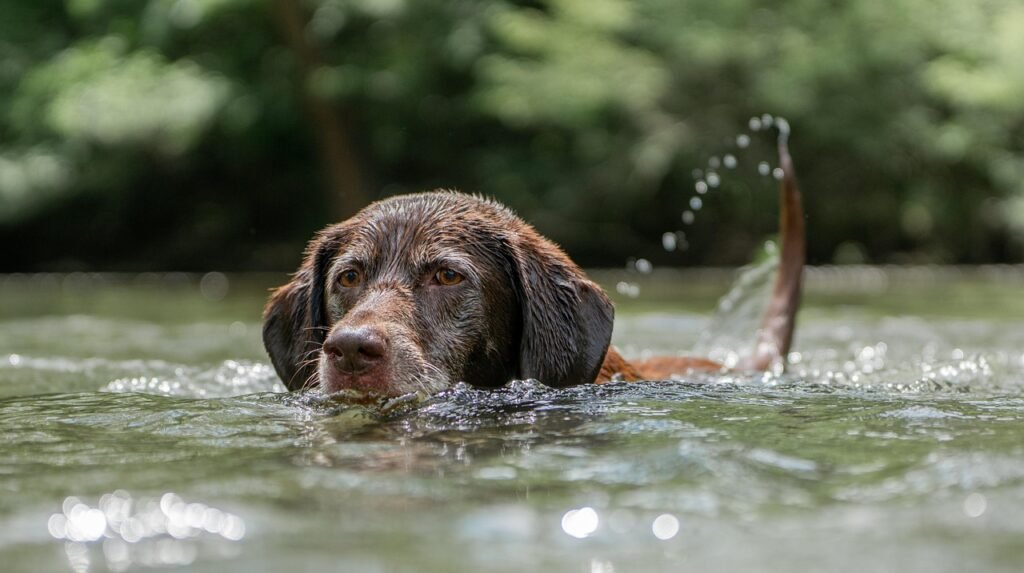
Where to go: Dog-friendly swimming spots near Montreal
There aren’t tons of off-leash beaches in Montreal, but there are a few great places to get your dog in the water safely.
Valois Bay Dog Park
Located in Pointe-Claire, Valois Bay Dog Park offers direct water access for dogs and is a rare off-leash swim spot on the island. The shoreline is shallow enough for first-timers, and the view isn’t bad either. It can get busy on weekends, so aim for early mornings or quieter weekdays if your dog needs space.
Parc Bertold
In Sainte‑Anne‑de‑Bellevue, Parc Bertold is a fenced, off‑leash dog park with easy shoreline access where pups often cool off. The enclosed area helps keep dogs safe while they relax near the water, and there are usually shallow spots ideal for hesitant swimmers.
Dog-friendly rentals in the Laurentians
If you’re planning a weekend escape, there are plenty of dog-friendly cottage rentals in the Laurentians with private lake access. Platforms like WeChalet and Airbnb let you filter by pet policies, and many hosts will confirm if dogs are allowed to swim or roam near the shoreline. Look for gradual water entry and check local leash rules before you head out.
Sniffspot
Sniffspot lets you book private, dog-friendly spaces by the hour, including fenced yards, swimming ponds, and pools. It’s a great option if your dog needs a quiet environment to build water confidence or you want to avoid the chaos of public parks.
Backyard or kiddie pool
There’s no rule that says swimming with dogs has to mean lakes and beaches. A plastic kiddie pool or even a backyard sprinkler can help build confidence, especially when your dog is free to move at their own pace.
Want more summer outing ideas? Check out Montreal’s most dog-friendly parks and patios this spring.
Progress takes practice
Swimming with dogs can be as fun and freeing as it looks on Instagram. But it can also be messy, unpredictable, and slow-going. What matters most is helping your dog feel safe and seen. That’s what makes swimming not just a fun summer activity, but a real opportunity for connection.
If you need help building your dog’s confidence around water, want to work on recall near distractions, or just want to make sure you’re doing it right, we’re here. Explore our training services or check out more blog posts for realistic, positive strategies that actually work.
Swimming with dogs FAQ
Do all dogs know how to swim?
No. Some need to learn gradually with support and clear guidance. Others may never feel comfortable — and that’s okay.
Should my dog wear a life vest?
Yes. It helps beginners stay level and gives you something to grab if needed. Look for one with bright colors, reflective trim, and a sturdy handle.
What if my dog panicked last time?
Reset. Start again in shallow water, reward curiosity, and take breaks often. Avoid rushing it or setting big expectations.
Can my puppy swim?
Maybe, but be cautious. Start in very shallow water. Puppies get tired quickly and are more sensitive to cold. Keep things short and positive.
How do I know when to stop?
If your dog starts slowing down, gulping water, or seems less coordinated, it’s time for a break. Swim sessions should be short and sweet.

